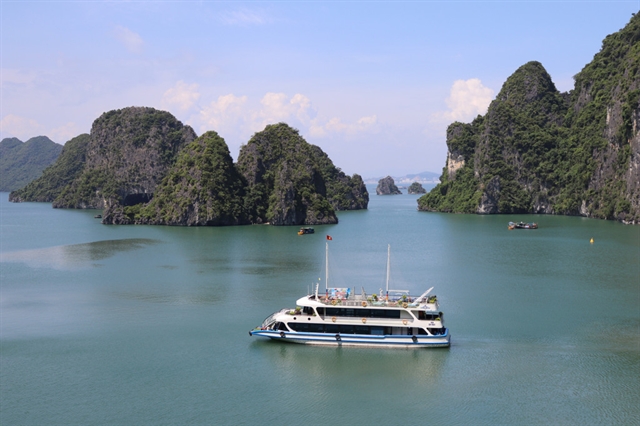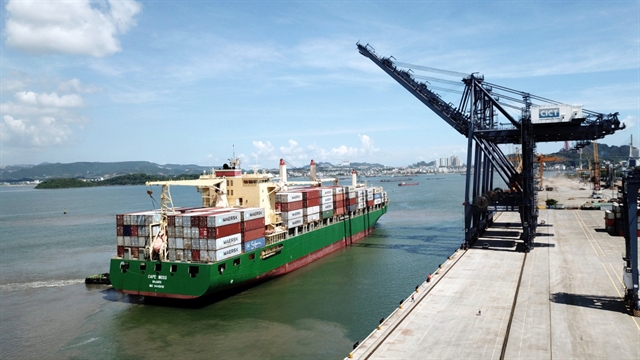 Economy
Economy

 |
| A cruise ship takes visitors on a tour of the UNESCO World Natural Heritage site, Hạ Long Bay. VNA Photo |
QUẢNG NINH — Tourism and sea economy continued to play large parts in the development strategy for the northern coastal province of Quảng Ninh, according to the province's People's Committee.
Home to Hạ Long Bay, a UNESCO World Natural Heritage site and a traditionally popular destination among domestic visitors, Quảng Ninh is primed to develop tourism infrastructure to welcome millions of tourists every year. The province has set an objective to increase sea tourism's share to 75-80 per cent of its total number of visitors by 2030 or 28.5 million, of which 8 million would be foreign visitors.
In order to realise the said objective, Quảng Ninh placed great importance on building a model of sustainable tourism and improving the quality of services across the board for visitors. Tourism alone could create nearly a quarter of a million jobs for local residents, according to the province.
Bùi Văn Khắng, deputy chairman of Quảng Ninh's People Committee, said in recent years Quảng Ninh had made significant investments in developing and upgrading its infrastructure networks to connect all tourism hubs to the major road networks in the Red River Delta.
Meanwhile, the province had been working with businesses and developers to set up far-reaching systems of malls, supermarkets, convenience stores, vending machines and traditional markets, all situated in close proximity to local tourist attractions.
The provincial authorities had also formed partnerships with large tourism brands, domestic and international, to develop its numerous islands in the Vân Đồn - Cô Tô and Móng Cái regions. Various key projects had been signed and construction was underway on many previously isolated and unpopulated islands, Khắng said.
In the coming years, more quality products and services were to become available to visitors, especially the high-end segment of the market.
Phạm Ngọc Thuỷ, head of the province's tourism department, said while there had been setbacks during the pandemic, the province stayed fully committed to a speedy recovery of the tourism industry and the long-term development of tourism infrastructure.
In addition, measures had been taken to address the low number of visitors to the province during Autumn and Winter, a key weakness of Quảng Ninh's tourism.
The province had been looking West for an answer where it houses some of the country's most diverse and well-preserved forests, as well as popular destinations among bikers and trekkers such as the Tiên Yên - Ba Chẽ - Bình Liêu mountain ranges. Thuỷ said steps had been taken to explore this direction and the province had greenlit a number of projects to set up infrastructure to accommodate visitors to the mountains.
Aside from natural wonders, Quảng Ninh is home to some 530 historic sites and some of the most distinguished folk festivals in Việt Nam. Most notably ancient rituals of the Tày of Bình Liêu, which have been recognised as UNESCO's intangible cultural heritage.
Sea economy
 |
| A container ship calls at Quảng Ninh Port, one of the country's largest deep-water ports. VNA Photo |
Quảng Ninh has traditionally played an important part in Việt Nam's northern region logistics network. The province is home to numerous seaports, some are among the most modern ports in the region.
According to the provincial People's Committee, Quảng Ninh aims to maintain an 18.5 per cent growth rate annually for its port industry.
By 2030, the province's total net income from the industry is projected to reach over VNĐ47.5 trillion (US$2 billion), or 3-3.5 per cent of the province's gross regional domestic product.
In addition, the province has set a course to expand its aquaculture production with a focus on improving connectivity with road infrastructure in the region. The province says it has been in the process to connect 80 per cent of its production centres to the northern highway networks.
The province aims to increase seafood production to 225,000 tonnes and export value to half a billion dollars by the end of 2030. In order to realise such objectives, Quảng Ninh has made it a top priority to create more jobs in the industry. The province is to add 50,000 jobs in aquaculture production alone, which will increase production by as much as 300 per cent.
With an eye on sustainable development, measures have been taken to raise awareness among fishing communities as well as the implementation of stricter environmental laws, aiming to protect and preserve the ocean's natural resources.
Various projects have also received the go-ahead to set up logistic centres, food processing hubs and repair shops for fishing vessels as the province looks to improve efficiency and create added value for seafood products. Meanwhile, three key aquaculture production centres have been set up using advanced modern technologies. VNS